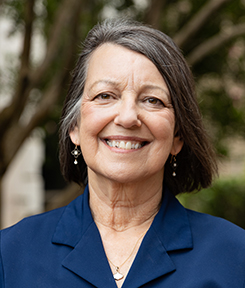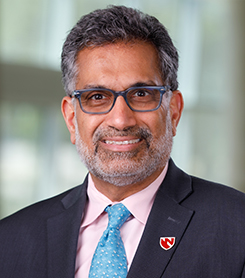For more than 100 years, APHA Press has published and updated the “Control of Communicable Diseases Manual,” a revered reference guide for health and medical professionals. The most recent edition was edited by David Heymann, MD, DTM&H, and first published in print in 2014; last year, an updated version was made available as an ebook and as a softbound book.
The upcoming edition of CCDM represents a departure in that it will be co-edited. The editors are Ali Khan, MD, MPH, MBA, dean of the University of Nebraska Medical Center College of Public Health, and Catherine Troisi, PhD, MS, an associate professor in policy, community health and epidemiology at UTHealth Houston School of Public Health. The print version of this edition will be published in several years, but chapters will be updated digitally on a regular basis prior to the print release.
The Nation’s Health spoke with Khan and Troisi about the influence of CCDM, likely additions to the new edition and the advantages of approaching the new edition as co-editors.
While print publication of the next edition may not be for several years, what about updates digitally?
Ali Khan: We're very fortunate to be the new co-editors of an esteemed publication that has been around since 1917, with over 100 years of history. In keeping with the advancements in infectious diseases, there are advancements in technology. Our expectation is that this book will be continuously edited, with new chapters available online that include the latest updates. We are no longer going to plan on periodically updating the whole book, but we’ll always make sure that there's a refreshed version available online.
Cathy Troisi: Some topics need updating more often than others. The idea, from talking to (current "Control of Communicable Diseases Manual" editor) David Heymann, was that every three years, one-third of the topics get updated. The entire book usually gets updated every five years, and the last one was published in 2022. We will likely have an updated physical copy of the CCDM in 2027. Our focus now is making sure that there's a continuously updated version available online for readers.
How did you use the CCDM during your careers?
Troisi: This was my reference book, and I would say I used it the most in teaching. I first started learning about infectious disease in a PhD program in biochemistry. I transferred to the Department of Epidemiology at Michigan because I wanted to study viruses. While I was in graduate school, Legionnaires’ disease happened, and the 1976 flu debacle. I fell in love with epidemiology. My whole career has been in infectious disease, particularly viral epidemiology.
Khan: I used it the most in clinical practice during my residency to get a quick snapshot on a disease and the critical issues with that disease, like causes, transmission, treatment and prevention strategies. I’ve used it as a reference throughout my public health career, and I still do.
Why should people use this book instead of other resources available online from the World Health Organization or the CDC?
Khan: This is curated knowledge. This is curated information by the globe's experts to make sure that they can get a quick snapshot of critical issues around the condition so that it is periodically updated and kept up to date by the editors. Instead of having to bounce around to multiple sources, this is your one-stop shopping.
There is the communicable disease manual, there's a laboratory book and there's an in-depth clinical book, so depending on where your expertise is, the “trilogy” really does meet the needs of practitioners, epidemiologists, public health workers and other individuals around infectious diseases.
Troisi: I would just reiterate that this is reliable information. There's so much misinformation on the web, and this is something that can be trusted.
Is there anything you might do differently compared to past editions?
Troisi: There will be the emphasis on the online edition and emphasis on use by folks in under-resourced countries where they may not have access to all the resources we have in the United States and Europe, in developed countries. I think there may be more emphasis on preparedness for infectious disease outbreaks, pandemics and bioterrorism than in the past.
Khan: I think it’s our commitment to keep this updated and topical, based on new conditions and new information as the knowledge is made available.
How did you decide to be co-editors?
Troisi: I am certainly excited to have somebody to help me in this. I was approached by APHA Executive Director Dr. Georges Benjamin, but I wasn't asked about a co-editor. They told me later that they were talking to Dr. Khan, which I'm extremely happy about. This is a big undertaking, I think, in terms of working together. We're still new on this.
Khan: Georges contacted me and asked me to edit the book and mentioned that there was going to be a co-editor. It’s great. It allows us a diversity of view. It allows us more opportunities to make sure that this remains topical and timely, which is important as opposed to the five-year refresh cycle we had previously. Now there are lots of ways to re-think the manual with co-editors as opposed to a single editor.
It also gives us more bandwidth for thinking about what ancillary products that may be related to the CCDM. One of the things that we've been thinking about is potentially having an open-source journal for emerging information, whereas CCDM is for established information.
What sections might you expand on?
Troisi: (More on) COVID will be added, for sure, because we're learning so much about the virus. The effects of climate change, which we talk a lot about, but I don't think we talk enough about the effect of climate change on infectious disease. We’re now seeing diseases in areas that we didn't used to because of warmer climate.
Khan: Besides the climate change and COVID, there’s an opportunity to think about what are the new emerging infectious diseases and how do we make sure that we are updating those chapters, especially since the epidemiology has been changing so much for a number of them. Even the avian influenza chapter, a lot has been going on recently. We'll have all sorts of brand-new vaccines like the RSV shot and others to talk about.
Our readers need to be assured that when they open their manual, electronically or physically, it's as up to date as it can be on what's happening and what's relevant to them for their practice. This was always seen as a practice-based manual since the initial edition. I'd like to make sure that we maintain that aspect of it as practice-based and not just something that sits on a shelf somewhere.
The interviews were edited for length and clarity.
Khan and Troisi are scheduled to be at the APHA Press booth at the Annual Meeting and Expo in Atlanta Sunday, Nov. 12, 1-3 p.m. and Monday, Nov. 13, 12-1 p.m. for a meet-and-greet.
For more on the CCDM e-book, visit www.aphabookstore.org.
Photo caption top: A boy receives a vaccination from a health worker. The new edition of CCDM, which is targeted to be published in 2027, will feature more on COVID-19 and other infectious diseases, including the impact of climate change on diseases. (Photo by FatCamera, courtesy iStockphotos)